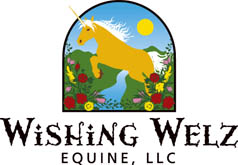LAMINITIS
by Dr. Hiltrud Strasser
The same steep hoof form is also responsible for a deficiency of blood flow
and chronic overload of the dorsal part of the laminae, which sets the stage
for acute laminitis.
A 12-year study of more than 200 coffin bones from slaughtered horses shows
that rarely does one find a coffin bone not deformed and damaged by improper
hoof shape. The palmar processes of a healthy coffin bone form an opening parabolic
shape, while in contracted hooves it shows an elliptic arch The length of a
healthy coffin bone equals its width; the commonly deformed coffin bone is narrower
than it is long.
The horse's weight, with each step, is equally distributed onto the laminae.
(In a calculation, this results in about 8kg per sq cm of laminae, at a canter.)
Horses live with this for 30-40 years even in rocky areas.
Studies of wild horses show the coffin bone of a natural foot parallel to the
ground and the frog/ bulbs actually touching the ground.
Domestic horses, however, are largely forced to live with high heels, and no
frog contact. A change in the distribution of pressure results; the steeper
the coffin bone, the more weight moves to the tip of the coffin bone and the
more the laminae there are overloaded. Soft ground is less harmful under these
conditions than hard ground.
The overloading of the laminae can be borne for some time if there is optimal
circulation and good horn quality (unshod hoof). If anything like a metabolic
disorder occurs, such as an excess in protein, the overloaded area becomes inoamed.
Horses show pain and shift their weight rearward, onto parts of the hoof where
the laminae is still intact.
With wild horses, actue laminitis heals quickly, since the animal has to migrate
with the herd, and circulation resolves the laminitis within a few days. The
rearward shift also shortens the overlong heels.
Veterinary treatment, however, focuses mainly on the innammation, or the already
occurred rotation of the coffin bone. However, seen from a pathophysiological
point of view, inflammation is a functional measure for repair: through increased
bloodflow, metabolism (the exchange of waste products for nutrients and oxygen)
is intensified. Basically, an inflammation is a natural repair mechanism; it
causes pain, but has a function, and suppressing it (as with anti-inflammatories)
prevents this natural healing mechanism from working.
This suppression of inflammation is usually done through medication and/or wedge
pads. Metabolism diminishes, and healing becomes slow if not impossible, since
healing requires increased metabolism.
Also, the use of wedge pads or bar shoes only increases the problem, doubling
the pressure put onto the damaged region. Cells in the already damaged area
die off, while cells on the edges of the afflicted area remain inflamed, producing
wound secretion instead of stabilizing horn. Acute laminitis, therefore, is
a long time in the making.
The "sudden" appearance of laminitis is brought on either by additional
overload or several possible poisonous ingredients; however, these are not the
causes for the laminitis, rather the "straw that broke the camel's back".
Pollitt shows dramatially in his video that a steep hoof is insufficiently supplied
with blood; this is especially severe when the horse moves little, because it
means long persisting vasoconstriction without the short frequent opening by
joint motion.
So far, 50 horses with acute laminits were healed exclusively by lowering the
palmar processes (bringing the hoof, and as such the coffin bone, back into
its original position through trimming), and optimizing blood flow through the
foot with movement, not medication or shoeing, etc.
Removing the cause (overload of the coffin bone) took 2-8 weeks, depending on
the stage of the disease at the beginning. After 3-5 months, as soon as 75%
of the coffin bone was tightly connected with the laminae again, the horse was
able to move pain-free.
Copyright Dr. vet. med. H. Strasser
Blaihofstr. 42/1, 72074 Tuebingen, Germany
Tel/Fax: (011) 49-7071-87572
Ed. & Canadian contact: Sabine Kells at email: textorder @ shaw.ca
©2006 by The Horse's Hoof. All rights reserved. No part of
these publications may be reproduced by any means whatsoever without the written
permission of the publisher and/or authors. The information contained within
these articles is intended for educational purposes only, and not for diagnosing
or medicinally prescribing in any way. Readers are cautioned to seek expert
advice from a qualified health professional before pursuing any form of treatment
on their animals. Opinions expressed herein are those of the authors and do
not necessarily reflect those of the publisher.
